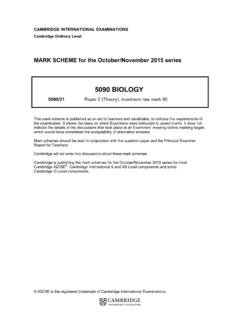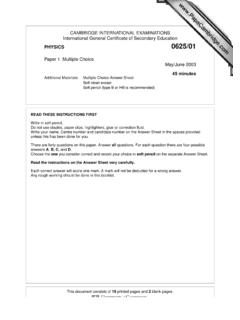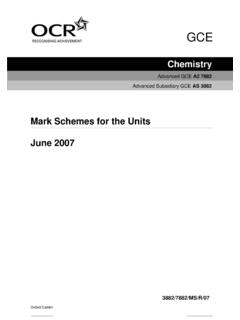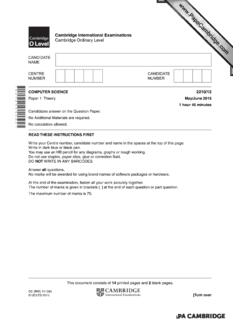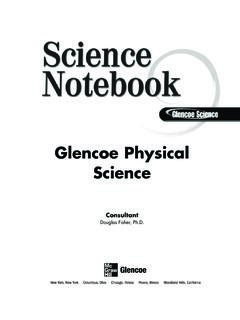Transcription of www.XtremePapers.com PHYSICAL SCIENCE 2 Paper 0652/01 ...
1 0652 PHYSICAL SCIENCE June 20031 PHYSICAL SCIENCE .. 2 Paper 0652/01 Multiple Choice .. 2 Paper 0652/02 Paper 2 (Core).. 4 Paper 0652/03 Paper 3 (Extended).. 6 Paper 0652/05 Practical 9 Paper 0652/06 Alternative to PHYSICAL SCIENCE June 20032 Paper 0652/01 Multiple ChoiceQuestionNumberKeyQuestionNumberKey 1C21A2B22C3B23D4C24C5C25D6A26B7D27A8B28A 9B29D10C30D11D31B12A32A13D33A14D34B15B35 D16D36D17B37A18B38B19C39A20A40 DGeneral commentsCandidates achieved a mean mark of with a standard deviation of These values are satisfactorybut a bit lower than hoped. The Paper is intended, primarily, to discriminate between candidates in the gradeC to grade G range. The Paper is also taken by candidates who achieve higher than grade C. This reportconcentrates more on the responses made by the grade C to G candidates. However, with only a smallentry, inferences from the statistics for the individual questions may not be wholly valid and this should beborne in would appear to have been well prepared.
2 Teachers and candidates are to be which the candidates seemed to find relatively easy (over 70% facility) were Questions 2, 21, 24,25, 26, 28, 33, 34, 35 and 39. Candidates found Questions 22 and 40 particularly on specific questionsQuestion 1 Response D was the most popular amongst the lower scoring candidates and this is rather puzzling in viewof the fact that the question refers to a warm 2 This question did not discriminate well, probably due to the fact that it was found quite easy across the wholeof the ability PHYSICAL SCIENCE June 20033 Question 4 This was found to be on the hard side and some 30% of the lower scoring candidates chose B rather thanthe key, C. Seeing that the first two atoms in the table are both non-metallic is straightforward but it neededa little more insight to realise that the third atom is a noble gas and, therefore, also 7 About 30% of the lower scoring candidates each chose either B, C or D.
3 This seems to imply fairlywide-ranging confusion about the litmus test and the testing of 8A question that did not discriminate particularly well. It seems that about a quarter of candidates across theability range chose C with another 10% across the range choosing D. Do these figures indicate somegeneral uncertainty about the behaviour of hydrogen and uranium as fuels?Question 11 Nearly 60% of the lower scorers chose B but the character of an explosion is very rapid reaction over a shorttime 12 Response C was quite popular with the lower scorers (40%), but it was also quite popular with the higherscorers (32%). See also Question 15 Although presented slightly differently, this question is essentially about recall of the characteristic propertiesof transition elements. Nevertheless, nearly half of the lower scorers chose 16A disappointingly hard question that did not discriminate well.
4 The most popular choice across the abilitywas response C, candidates obviously forgetting that sodium + acid is violently reactive. Anotherdisappointment is that quite a lot of candidates across the ability range continue to think that copper reactswith dilute 18 Another disappointing question with so many candidates across the ability range thinking that hydrogen is aproduct of the incomplete combustion of 20 This also was disappointing. Response C was the most popular across the ability range but, with responseB, these two responses thoroughly outweighed the key, A. Admittedly, butene is likely to be unfamiliar butthe syllabus is expressed in general terms, describe the properties of alkenes in terms of addition ofhydrogen and describe the formation of poly(ethene) as an example of addition polymerisation of monomerunits .Question 22 The vast majority of candidates knew that they had to divide distance by time.
5 The problem was that most ofthese did not convert minutes to hours first. Units are always important in SCIENCE questions, andcandidates should be aware of the units in any 27 This was not particularly well done, with under half answering correctly. What was surprising was that aquarter of candidates thought that work and power would be increased when lifting the lighter these candidates had some notion that by then the labourer would be tired and that this meant hewould have to exert more PHYSICAL SCIENCE June 20034 Question 29 About two-thirds of candidates answered this correctly, but a quarter thought that frequency changes 30In a similar manner, less than half realised that 200m is a wavelength, but almost as many thought that it isfrequency. Candidates should know that metres cannot be a 32 This was not answered correctly by as many as hoped, and 38% simply assumed that since there wasattraction in both the situations in the stem, then when the metal rod is turned round, then both must 36 and 37 The action of fuses was not well understood in Question 36, and neither was the division of voltages in thesimilar Question 40 Half-life still causes confusion in the minds of many candidates.
6 Less than a quarter answered this majority spotted that four half-lives were involved, and simply multiplied by 0652/02 Paper 2 (Core)General commentsThe Paper was fairly challenging and allowed candidates to show their abilities. The vast majority were ableto answer all of the questions, albeit with varying levels of success. It is encouraging that very poor scriptswere relatively few, whilst the number of good and excellent scripts continues to on specific questionsQuestion 1 This question, which tested candidates knowledge of the basic structure of atoms, and their ability tointerpret the meaning of atomic notation, was done well making it clear that the majority of candidates had agood understanding of this basic 2 This quite challenging question caused very much more difficulty. It is disappointing that so few candidateswere able to look at the diagram and see that there were two separate circuits (this, despite the relay beingspecifically in the syllabus).
7 Although some candidates were aware that a magnetic field was set up in theiron core, very few understood that the steel armature would be attracted to the core closing the calculation in part (b), however, was done very well - with most candidates using the correct 3 This question explored the candidate s knowledge and understanding of simple bonding, structural formulaeand molecular masses. The dot-cross diagram was well done by the majority of candidates and, by andlarge, most candidates recognised it as co-valent PHYSICAL SCIENCE June 20035 The structural formula for the alcohol molecule was not so well understood, with the majority of candidatesjust totalling up the atoms to give CH4O and, while this does give the correct number of atoms, it does notshow their grouping as CH3OH calculation of atomic mass was done quite well, but a significant number of candidates added Proton(Atomic) Number, rather than Nucleon (Mass) 4 The diagram of the passage of light through the lens was generally well done - but candidates cannot expectto score full marks with free hand drawings; rulers and pencils should always be used for completing raydiagrams.
8 The identification of the angle of incidence caused more problems than one might expect. Also,credit was lost by those candidates who did not take care in drawing the reflected ray so that their angle ofreflection was not equal to the angle of 5 Another question which explored candidates understanding of bonding, although more challenging in thisexample. Whilst many candidates were able to give the structure of the ethane molecule, the double bond inethane caused many problems. The effect of adding bromine to the two substances was quite well , the first part of the question, the reaction of bromine and the iodide ion in potassium iodide causedmajor problems. Very few candidates tackled the question in terms of electron exchange, which limited thecredit they could gain. Even then, few candidates really said anything which showed an understanding ofthe 6 This was a deceptively difficult question, and few candidates scored full marks.
9 For a thermometer going upto 110 C, mercury must be used. The reading of 35 was generally done correctly, although some read it The explanation of the narrow capillary tube - in terms of improving sensitivity, not accuracy - wasdone very poorly. However, many candidates gave a good description of the cooling and contracting of 7 Knowledge and understanding of the Kinetic Theory of Matter is notoriously poor. Molecules do not think,therefore they cannot want to do anything. In part (a), the energy is required to move the molecules apartand give them more potential energy. They do not increase their kinetic energy further whilst the substanceis at melting point (the temperature remains constant!). The ink spreads out because of the randommovement of both ink and water molecules; to give an answer naming the term diffusion does not answer thequestion that was 8 Carelessness in drawing the direction of the waves in the shallow water cost many candidates credit.
10 Thedirection of movement of the waves is always perpendicular to the wavefront and, to score this mark,candidates were required to show this with some 9 This question discriminated well at the C/D level, with those candidates scoring well. However, marks werelost in part (c) because candidates did not give a full 10It was pleasing that a large number of candidates recognised that there must be movement for work to bedone. However, fewer linked the movement to the applied force. The calculation of weight was quite welldone and most candidates recognised the box would fall with acceleration, if not constant acceleration, andonce again many candidates continue to write, -accelerating with constant speed .Question 11 Too few candidates explained oxidation in terms of exchange of electrons; also, many failed to link it to theexample given. Part (b) required candidates to explain that energy is released in the combustion ofhydrogen - thereby making it useful as a fuel, and the final part required candidates to explain that the onlyproduct of combustion was PHYSICAL SCIENCE June 20036 Paper 0652/03 Paper 3 (Extended)General commentsThis optional Paper was successful in that realistic candidates for the higher grades could demonstratepositive achievement.


